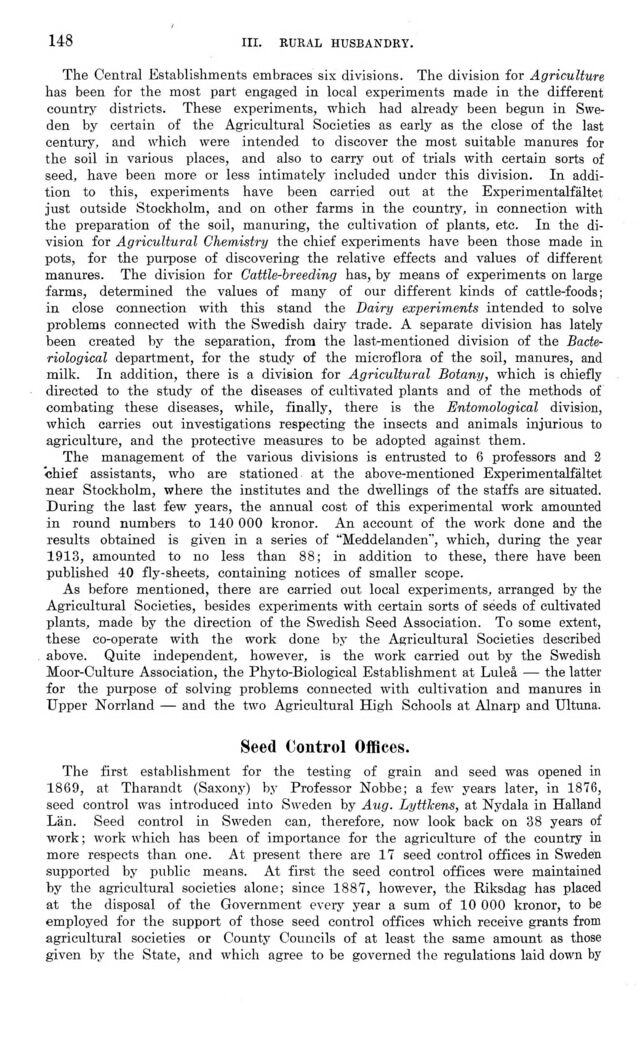
Full resolution (JPEG) - On this page / på denna sida - III. Rural Husbandry. Introd. by H. Juhlin Dannfelt - 4. Public and Private Institutions for the Advancement of Agriculture. Introd. by W. Flach - Agricultural Experimental Institutions. By M. Weibull - Seed Control Offices. By A. Vilke

<< prev. page << föreg. sida << >> nästa sida >> next page >>
Below is the raw OCR text
from the above scanned image.
Do you see an error? Proofread the page now!
Här nedan syns maskintolkade texten från faksimilbilden ovan.
Ser du något fel? Korrekturläs sidan nu!
This page has never been proofread. / Denna sida har aldrig korrekturlästs.
1-2-2
iii. rural husbandry.
The Central Establishments embraces six divisions. The division for Agriculture
has been for the most part engaged in local experiments made in the different
country districts. These experiments, which had already been begun in
Sweden by certain of the Agricultural Societies as early as the close of the last
century, and which were intended to discover the most suitable manures for
the soil in various places, and also to carry out of trials with certain sorts of
seed, have been more or less intimately included under this division. In
addition to this, experiments have been carried out at the Experimentalfältet
just outside Stockholm, and on other farms in the country, in connection with
the preparation of the soil, manuring, the cultivation of plants, etc. In the
division for Agricultural Chemistry the chief experiments have been those made in
pots, for the purpose of discovering the relative effects and values of different
manures. The division for Cattle-breeding has, by means of experiments on large
farms, determined the values of many of our different kinds of cattle-foods;
in close connection with this stand the Dairy experiments intended to solve
problems connected with the Swedish dairy trade. A separate division has lately
been created by the separation, from the last-mentioned division of the
Bacteriological department, for the study of the microflora of the soil, manures, and
milk. In addition, there is a division for Agricultural Botany, which is chiefly
directed to the study of the diseases of cultivated plants and of the methods of
combating these diseases, while, finally, there is the Entomological division,
which carries out investigations respecting the insects and animals injurious to
agriculture, and the protective measures to be adopted against them.
The management of the various divisions is entrusted to 6 professors and 2
chief assistants, who are stationed at the above-mentioned Experimentalfältet
near Stockholm, where the institutes and the dwellings of the staffs are situated.
During the last few years, the annual cost of this experimental work amounted
in round numbers to 140 000 kronor. An account of the work done and the
results obtained is given in a series of "Meddelanden", which, during the year
1913, amounted to no less than 88; in addition to these, there have been
published 40 fly-sheets, containing notices of smaller scope.
As before mentioned, there are carried out local experiments, arranged by the
Agricultural Societies, besides experiments with certain sorts of seeds of cultivated
plants, made by the direction of the Swedish Seed Association. To some extent,
these co-operate with the work done by the Agricultural Societies described
above. Quite independent, however, is the work carried out by the Swedish
Moor-Culture Association, the Phyto-Biological Establishment at Luleå — the latter
for the purpose of solving problems connected with cultivation and manures in
Upper Norrland — and the two Agricultural High Schools at Alnarp and Ultuna.
Seed Control Offices.
The first establishment for the testing of grain and seed was opened in
1869, at Tharandt. (Saxony) by Professor Nobbe; a few years later, in 1876,
seed control was introduced into Sweden by Aug. Lyttkens, at Nydala in Halland
Län. Seed control in Sweden can, therefore, now look back on 38 years of
work; work which has been of importance for the agriculture of the country in
more respects than one. At present there are 17 seed control offices in Sweden
supported by piiblic means. At first the seed control offices were maintained
by the agricultural societies alone; since 1887, however, the Riksdag has placed
at the disposal of the Government every year a sum of 10 000 kronor, to be
employed for the support of those seed control offices which receive grants from
agricultural societies or County Councils of at least the same amount as those
given by the State, and which agree to be governed the regulations laid down by
<< prev. page << föreg. sida << >> nästa sida >> next page >>